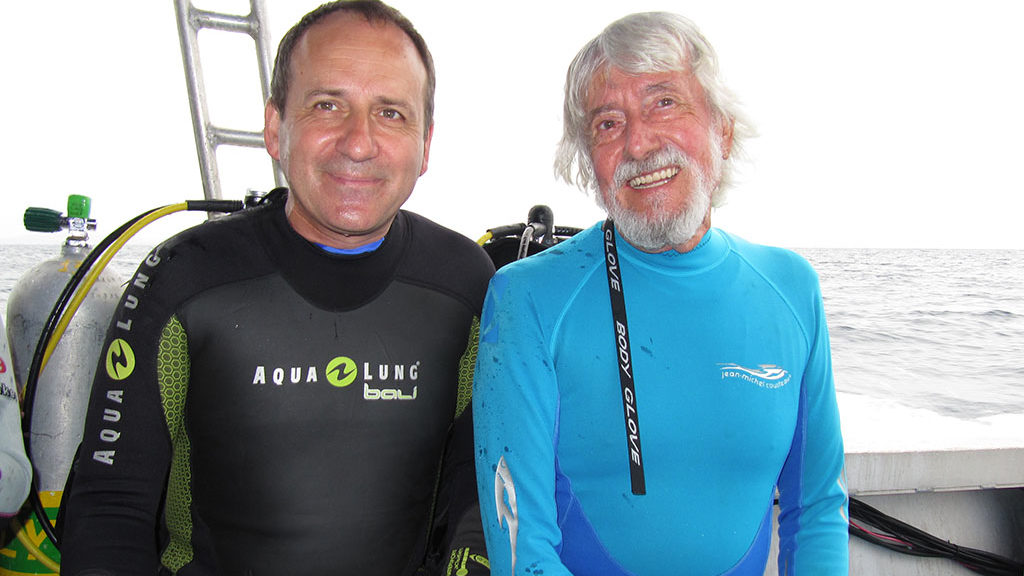
Protéger l’Océan
La cause des causes : le nombre
Surpopulation et concentration ! Depuis 1910, la population a plus que triplé pour atteindre aujourd’hui plus de 7 milliards d’individus. À cette explosion démographique s’ajoute un phénomène de concentration sur les bandes côtières.
Aux États-Unis, 53 % des habitants vivent sur 10 % du territoire, à moins de 80 km des côtes. En France, 10 % de la population réside sur une frange littorale représentant moins d’un millième du territoire. Mondialement, la moitié de la population vit à moins de 50 km des côtes.
De nombreux scientifiques s’accordent à penser qu’il s’agit d’une des causes fondamentales de nos maux.
Une seule eau sur la planète: le grand Océan
C’est une évidence trop souvent ignorée : il n’y a qu’une seule eau sur la planète, l’eau douce représentant moins de 3 % du total. Depuis la neige qui fond et se mélange aux ruisseaux, aux rivières puis aux fleuves, tout finit à la mer, c’est-à-dire dans l’océan. L’évaporation perpétue ce cycle avec les pluies. Ainsi, que nous vivions à l’intérieur des terres ou au bord des côtes, nous avons tous un impact sur le milieu marin.
Les causes de la dégradation
Les principales causes de la dégradation de la nature sont :
- la destruction mécanique des habitats du fait des constructions (immeubles, barrages, marinas, ports…) ;
- les prélèvements excessifs (chalutage, pêche à pied par des vacanciers en surnombre…) ;
- l’introduction d’espèces étrangères (ex. Caulerpa taxifolia en Méditerranée) ;
- les rejets de toutes sortes, dans l’atmosphère, dans les décharges et dans l’eau: plastiques, produits chimiques, etc.
La vision de Jean-Michel Cousteau

1. Quels changements avez-vous vu apparaître au cours des six dernières décennies ?
En dehors du changement climatique, je vois trois problèmes, tous causés par notre propre comportement :
- le fait que nous considérions l’océan comme une poubelle ;
- la destruction des habitats côtiers ;
- la surpêche.
La bonne nouvelle, c’est qu’il y a des solutions. Elles sont amenées par la science, le bon sens commun, une attention particulière aux animaux qui sont des sentinelles, un engagement profond envers ce que nous aimons, à l’image de l’incomparable beauté de la mer, et nos enfants car ils représentent le futur.
2. En quoi les animaux sont-ils des sentinelles ?
Les animaux, et en particulier les animaux marins, sont des sentinelles car ce qui leur arrive aujourd’hui nous arrivera demain. Par exemple, les analyses faites sur les cétacés (qui comme nous sont en bout de chaîne alimentaire) montrent une concentration de substances de toutes sortes, rejetées à la mer par les hommes, avec de graves conséquences à la clef : diminution des résistances aux maladies, transmission des produits toxiques aux nouveau-nés par le lait maternel, décès prématurés…
Protéger les océans, c’est nous protéger nous-mêmes.
3. Lors de vos expéditions, avez-vous pu mesurer par vous-même l’impact des rejets en mer ?
Je prendrai l’exemple des îles du nord-ouest à Hawaï, les plus isolées au monde, longtemps restées vierges de toute influence humaine. Partie intégrante du système océanique, elles subissent l’influence du gyre du Pacifique Nord, un énorme courant circulaire parcourant la planète dans le sens des aiguilles d’une montre. D’Ouest en Est, il traverse le Pacifique Nord, descend le long des côtes nord-américaines puis d’Amérique centrale et repart ensuite, d’est en ouest, à travers le Pacifique pour atteindre les côtes du Japon.
Historiquement, ce courant charriait des bois flottés qui occasionnellement transportaient plantes et animaux peuplant alors les terres sur leur passage. Ce lent processus de colonisation s’effectuait sur des centaines d’années. Récemment, j’ai marché sur les plages de l’île de Laysan et j’ai pu voir ce que le gyre du Pacifique Nord apporte aujourd’hui : seringues, écrans d’ordinateur, brosses à dents, jouets, filtres de cigarettes, plastiques de toutes sortes… C’est la Grande Poubelle du Pacifique, affectant toutes les espèces marines sur son passage.
Ces déchets s’accumulent sur une surface représentant deux fois celle de la France !
4. Quelles sont les solutions ?
Philosophiquement, la chose est simple à énoncer :
- ne pas surconsommer et n’acheter que ce dont on a réellement besoin;
- ne rien rejeter dans la nature.
C’est une solution personnelle et individuelle qui ne requiert aucun changement industriel et aucune décision politique. Bien entendu, il est nécessaire de disposer d’emballages biodégradables et de produits recyclables, mais ce qui compte avant tout c’est de ne rien rejeter dans la nature, pas plus sur terre et dans les airs que dans les rivières, fleuves et océans où tout finit en définitive.
Il nous faut abandonner le « réflexe du singe » qui, après avoir mangé une banane, rejette la peau par terre! C’est encore ce que nous faisons aujourd’hui y compris dans les pays les plus développés : plastiques, produits manufacturés, polluants et autres substances sont encore trop souvent simplement rejetés dans la nature, entassés dans des décharges.
5. Pourquoi a-t-on ce réflexe ?
C’est un réflexe ancestral, ancré en nous. Il est amplifié par la conviction que la dilution c’est la solution. Longtemps, nous avons cru que les produits rejetés dans l’air ou dans l’eau se diluaient et disparaissaient. Or, ce n’est pas vrai, tout particulièrement pour les produits chimiques et les métaux lourds qui chaque jour s’accumulent dans les océans.
L’analyse du corps de baleines échouées dans le Pacifique Est a montré une contamination au PBDE (Polybromodiphényléther), un produit chimique utilisé pour ignifuger les produits plastiques et les textiles que l’on retrouve dans les jouets pour enfants, les canapés, etc. Ces produits sont d’abord présents dans l’air puis ils pénètrent dans l’eau et entrent dans la chaîne alimentaire, s’accumulent dans les graisses des animaux en bout de chaîne et constituent une menace pour leur santé. C’est le cas aujourd’hui pour de nombreuses espèces de mammifères marins : les grands dauphins vivant le long des côtes des États-Unis, les baleines à fanons (bien qu’elles se nourrissent dans les eaux profondes), les phoques et marsouins en mer du Nord, etc. Cela préfigure ce que nos enfants pourraient subir dans le futur.
Pour prévenir cela, il faut un changement radical de logique industrielle en exigeant que les produits fabriqués soient certifiés « sans risque » AVANT d’être mis sur le marché. Il ne faut plus attendre que le problème se pose pour tenter d’y remédier. Il est irresponsable de la part des entreprises de se rendre compte, trente ans après sa commercialisation, qu’un produit est dangereux. Les gouvernements doivent en prendre conscience et modifier la réglementation en ce sens. Les citoyens, par leur vote et le choix des produits achetés préférentiellement, doivent également avoir une influence. Mieux vaut prévenir que guérir !
6. En quelque sorte, vous prônez une prise de conscience globale de notre appartenance à la planète…
Oui. Pendant des centaines d’années, nous avons vu la nature comme un assemblage de différentes espèces sans lien entre elles, la science identifiant et classant les différentes « pièces détachées » du système. La disparition de certaines de ces « pièces » nous fait aujourd’hui prendre conscience que la nature est un tout et que pour que la planète soit habitable nous avons besoin de chaque espèce. La nature nous fournit de l’air respirable, de l’eau fraîche, de la nourriture, des matières premières et un environnement agréable. Nous devons donc protéger sa biodiversité pour nous protéger nous-mêmes.
A titre d’exemple, avec mes enfants Fabien et Céline ainsi que les membres de mon équipe, nous avons plongé dans les eaux du Florida Keys National Marine Sanctuary en compagnie de mérous géants (Epinephelus itajara) appelés également loches. Ils peuvent atteindre 2,50 m et peser plus de 300 kg. L’espèce est aujourd’hui menacée de disparition car les pêcheurs n’avaient pas compris que, quand ils étaient faciles à attraper, c’est qu’ils se regroupaient pour se reproduire et qu’il fallait les laisser en paix. À ce facteur s’est ajoutée une cause supplémentaire que nous avons mis du temps à identifier : lors de la ponte, les oeufs sont transportés sur des milliers de kilomètres pour atteindre des zones propices aux alevins telles que les mangroves. Les jeunes mérous y séjournent alors leurs sept premières années avant de rejoindre les eaux profondes et d’atteindre la taille gigantesque que nous leur connaissons.
En ignorant ce phénomène, l’homme détruit les mangroves sans autres précautions, pensant qu’elles ne sont qu’un obstacle au développement industriel et touristique. En oubliant leur rôle fondamental de nurseries, nous accélérons encore la disparition de ces grands mérous.
7. Là encore, quelle solution ?
Il faut recréer ces habitats que nous avons détruits et réaliser à quel point ils sont importants pour la santé des océans et l’économie humaine. Nous ne pouvons pas nous permettre de prendre le risque d’hypothéquer la vie sous-marine en bétonnant sans cesse les côtes du littoral sur toute la planète.
Il faut également une prise de conscience globale du problème de la surpêche qui menace d’extinction des dizaines d’espèces : mérous, thons, espadons, requins… Avec pour conséquence première des difficultés économiques pour les pêcheurs eux-mêmes. La solution pour lutter contre cette surpêche est la création d’aires marines protégées. Ce n’est pas une idée nouvelle.
J’ai vu aux îles Fidji, il y a de cela plusieurs années, que quand un grand chef mourait, une partie du récif était sanctuarisée et interdite à la pêche. La raison tenait au fait qu’un an après, les habitants du village rendaient hommage à leur chef décédé en faisant une grande fête qui nécessitait de disposer de beaucoup de poisson. En procédant ainsi, ils étaient certains de disposer de suffisamment de poisson. De nombreux peuples pêcheurs assurent leur nourriture future en protégeant certains territoires.
Aux États-Unis, la première aire marine protégée n’a rien à voir avec la protection des espèces marines. À Cap Canaveral, une grande partie de la zone située autour de l’aire de lancement des fusées avait été interdite à toute activité de plaisance et de pêche, pour protéger les usagers d’éventuelles retombées. Quelques années plus tard, nous nous sommes rendu compte que cette zone était devenue extrêmement poissonneuse.
Les scientifiques ont alors étudié le phénomène et mis en avant l’efficacité d’une protection totale en matière de repeuplement. En à peine trois ans, certaines espèces sont capables de renverserla tendance et de recommencer à se développer.
8. Êtes-vous optimiste ?
Oui, je le suis. Notre programme éducatif « Ambassadeurs de l’environnement » porte ses fruits. Les habitudes de consommation changent, les comportements évoluent dans le bon sens.
Les plongeurs et les moniteurs de plongée sont des témoins privilégiés qui, par leur action au quotidien, ont un rôle important à jouer.
Il nous faut persévérer dans cette voie…
Texte extrait de Plongée Plaisir 4, reproduction interdite sans accord écrit de l’auteur.

